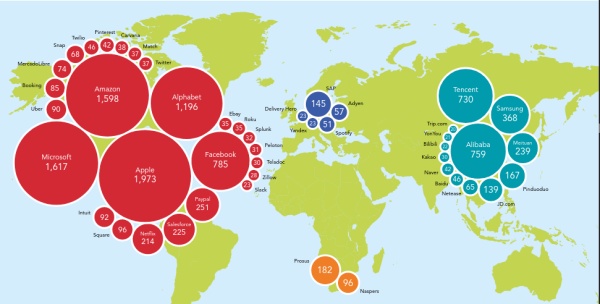The Big Tech Model
Knowing exactly how they harm you is the first step of liberation.

Preface: This post should be read together with the one on “Websoft Giants” and is a prelude to another one about the financialisation of Big Tech.
The Centre for Research on Multinational Corporations (SOMO) is an independent, not-for-profit organization working on social, ecological and economic issues related to sustainable development. SOMO just released a report on how COVID-19 accelerates the monopoly position of Big Tech, and in my opinion everydoby should read it, because it matters. To motivate people to do it, I am synthesizing here one of its sections.
The Big Tech model
What could be called “Big Tech Model” is based on three main features: monopoly rents, financialisation and platformisation.
The first two recur in the history of modern capitalism. Platformisation is how the same features are expressed and augmented under contemporary digital-and-digitising capitalism. The Big Tech platforms share four essential characteristics:
Intermediation: the platforms function as intermediary infrastructures that bring different user groups together, from app stores to social networks.
Network effets: the larger the platform’s size or user base becomes, the more it is profitable, and harder to replace. For this reason, besides growing internally, platforms tend to enhance their scope. Amazon started selling books, and Microsoft operating system. Now they both do much more than that. This is a “self-reinforcing cycle, creating an ever widening gap between the platform and its competitors”.
Cross-subsidisation: in plain English, this is simply the practice, if not the deliberate strategy, of offering services for free, or accepting financial losses to increase market share, and hence network effects.
User engagement: to succeed and stay successful, platforms need to be addictive. They are deliberately designed to keep users online for as long as possible, in order to extract the greatest possible amount of data. For more on this, and its effects, see here, here or here.
Not your old man’s capitalism
Right now, academics are debating whether this whole phenomenon, commonly called platform capitalism or surveillance capitalism, is just more of the same stuff we enjoyed in the late 20th century, or something qualitavely new.
Whatever the outcome of that debate is, three things are hard to ignore, or contest:
- this phenomenon is based on data extraction or, as the reports puts it, “What is new in the digital age is… the rampant ‘assetisation’ of digital footprints, turning personal data into commercial datasets”
- “assetisation” modifies behaviour, of both individuals, and society as a whole. If you need any proof of this, in addition to the links above please do also read my posts about polarization and anxiety.
- treating this disease by “breaking up companies” is a pointless idea. The report hints at this when it talks of “Academic notions and measurements of seeking, creating and exploiting monopolies remain contested”. Me, I explained this in several posts, starting from this and this, about the Warren proposal of 2019
Who writes this, why, and how to help
I am Marco Fioretti, tech writer and aspiring polymath doing human-digital research and popularization.
I do it because YOUR civil rights and the quality of YOUR life depend every year more on how software is used AROUND you.
To this end, I have already shared more than a million words on this blog, without any paywall or user tracking, and am sharing the next million through a newsletter, also without any paywall.
The more direct support I get, the more I can continue to inform for free parents, teachers, decision makers, and everybody else who should know more stuff like this. You can support me with paid subscriptions to my newsletter, donations via PayPal (mfioretti@nexaima.net) or LiberaPay, or in any of the other ways listed here.THANKS for your support!